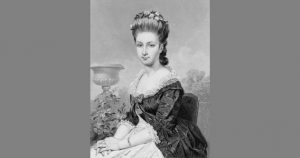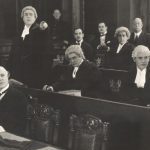 History
History  History
History  Weird Stuff
Weird Stuff 10 Superstitious Beliefs That Once Consumed Entire Cultures
 History
History 10 Bizarre Friendly Fire Incidents in Military History
 Technology
Technology 10 Modern Technologies That Accidentally Imitate Ancient Magic
 Mysteries
Mysteries 10 Mysteries of the Human Genome
 Weird Stuff
Weird Stuff 10 Things So Rare They’ve Only Been Found Once
 History
History 10 Legends Whose Last Moments Undid Their Glory
 Health
Health 10 Futuristic Ideas to Treat Common Medical Problems
 Weird Stuff
Weird Stuff Ten Surreal Attempts to Reverse Baldness
 Facts
Facts 10 U.S. Government Contingency Plans for the Unthinkable
 History
History 10 Odd Things Colonial Americans Kept at Home
 Weird Stuff
Weird Stuff 10 Superstitious Beliefs That Once Consumed Entire Cultures
 History
History 10 Bizarre Friendly Fire Incidents in Military History
Who's Behind Listverse?

Jamie Frater
Head Editor
Jamie founded Listverse due to an insatiable desire to share fascinating, obscure, and bizarre facts. He has been a guest speaker on numerous national radio and television stations and is a five time published author.
More About Us Technology
Technology 10 Modern Technologies That Accidentally Imitate Ancient Magic
 Mysteries
Mysteries 10 Mysteries of the Human Genome
 Weird Stuff
Weird Stuff 10 Things So Rare They’ve Only Been Found Once
 History
History 10 Legends Whose Last Moments Undid Their Glory
 Health
Health 10 Futuristic Ideas to Treat Common Medical Problems
 Weird Stuff
Weird Stuff Ten Surreal Attempts to Reverse Baldness
 Facts
Facts 10 U.S. Government Contingency Plans for the Unthinkable
Ten of America’s Totally Forgotten Founding Mothers
Most American students and history buffs know all about the founding fathers of the United States. Men like Benjamin Franklin, George Washington, John Adams, James Monroe, John Hancock, and many more are studied in history class and read about by millions. They are celebrated with their pictures on money, their portraits in museums, and their legacies known everywhere across the country.
But they weren’t the only people who had a hand in forming the United States more than two centuries ago. There were plenty of women who worked hard behind the scenes to push for American independence too.
This list highlights ten founding mothers of the United States. You may well recognize some of these names, of course. But if you’re like most American history students, you don’t know much about their stories.
Sit back and dig in as we take a look at ten important women who did their part to help to free the American colonies from British rule and create the United States of America. And the next time July 4th comes around, you can feel a little more pride in having learned about all the people behind the country’s inspiring drive toward freedom. This is real girl power—from history!
Related: 10 Lesser-Known Facts About Revolutionary-Era America
10 Mercy Otis Warren
Mercy Otis Warren was a descendant of people who came to America on the Mayflower. Her husband James was also descended from Mayflower pilgrims, so their union brought together two of Massachusetts’s first families.
As was customary for women in the 18th century, Mercy didn’t receive much formal education. But when she was growing up, her father did allow her to attend tutoring sessions held for her brothers. They both entered Harvard College as young men, so Mercy undoubtedly received an excellent education in those tutoring lessons.
While her brothers studied formally, Mercy used that education to write. She produced poetry, pamphlets, and plays. All of them were published under a pseudonym—again, a normal practice for women of that time who hoped to write. In all her published works, Mercy showed significant support for American independence. She wrote glowingly of the protests in Boston that bubbled up over the Stamp Act of 1765. She also detested the fact that British troops were occupying Boston at the time. So she began corresponding with male Revolutionary leaders. Because she was such a good writer and quick thinker, she convinced them to adopt many of her pro-independence views and theories.
Her work after the Revolutionary War held a similar sway too. She regularly corresponded with several founding fathers as they prepared for the Constitutional Convention. When those men first submitted the Constitution for ratification, it was written up without a Bill of Rights. Mercy didn’t care for that and vigorously argued in published pamphlets that the document should only be adopted with a Bill of Rights attached. That alone ought to place her in a pantheon of American legends!
Following the adoption of the Constitution as we know it today, Mercy then published one of the first—and most in-depth—histories of the American Revolution. A prolific writer all her life, Mercy’s impressive body of work helped guide public opinion and consciousness during America’s founding days.[1]
9 Mary Norris Dickinson
John Dickinson was a noted member of the delegation to the Constitutional Convention. But once there in 1776, he refused to sign the Declaration of Independence even though his delegation moved for it. He believed the stated rights within the document could result in violence against others. That very much went against his religious principles as a Quaker. His wife, Mary Norris Dickinson, was also a Quaker, and she was the driving force behind his stance. She was committed to a life of non-violence, and she also believed in the Society of Friends’ push for equality between the sexes.
So she convinced John to argue for alterations to the Constitution before it was published. And she was no wilting violet on the matter, either. Mary was a significant landowner and had one of the largest private libraries in North America during the Constitutional Convention, so her worries mattered a great deal to John. Her influence led him to push for more non-violence both in the Constitution itself, as far as a Bill of Rights was concerned, and in the way America was eventually formed.
Mary actively participated in political discussions and frequently hosted delegates for dinner in her home during the Revolutionary Era. There, she drew other women into heated political discussions. She also used her influence in high society to advocate for a Bill of Rights, equal treatment of men and women before the law, and voting rights for women. Some conservative-minded individuals were dismayed by Mary’s active involvement in politics, as it went against the tradition of women withdrawing from discussions after dinner. But she refused to be moved by the old guard.
Despite the British burning some of her estates during the Revolution, Mary’s library survived. In 1784, Mary and John donated land and the library to Benjamin Rush to establish a new college. In their honor, Rush named the institution John and Mary’s College. Today, this college still operates and is known as Dickinson College. And Mary is forever known for equal rights activism at a time when it was not commonplace.[2]
8 Elizabeth Schuyler Hamilton
Elizabeth “Eliza” Schuyler came from two affluent clans in New York: the Schuylers and the Van Rensselaers. She met her future husband, Alexander Hamilton, while he was serving as a staff member for George Washington in Continental Army encampments in New Jersey in 1780. The two married that very same year at the Schuyler mansion in Albany.
As Hamilton’s new bride, Eliza had a major impact on the development of the Constitution and the emerging federal government. She helped draft his contributions to the Federalist Papers during the debates over the ratification of the Constitution.
Through it all, Eliza faced personal challenges, including a miscarriage. She also suffered through the news of her husband’s affair, which resulted in a temporary separation. However, they ultimately reconciled. When George Washington was preparing his Farewell Address, much of the essay was written by Hamilton. Eliza secretly contributed greatly to the work, though scholars wouldn’t figure that out for nearly 200 years.
After the tragic deaths of her son and husband in duels, Eliza co-founded the Orphan Asylum Society in New York. She dedicated over four decades to the society. The rest of her life was spent raising funds, collecting supplies, and supervising the education and care of over 700 orphaned and abandoned children. Today, the society is still active under the name Graham Windham.
Eliza also worked tirelessly to repair her husband’s legacy and preserve his writings and personal papers. To that end, history now has a much better understanding of Alexander Hamilton’s life, career, and opinions. Eliza outlived her husband by fifty years and passed away in 1854. She was laid to rest near Alexander in the Trinity Church graveyard in New York. Her contributions to the early days of the United States, including her tireless work for the orphaned and abandoned, helped shape the country into what it is today.[3]
7 Abigail Adams
Abigail Adams was a remarkably intelligent woman and an accomplished writer. She composed letters to many founding fathers urging them toward independence, democratic government, and support for women’s rights. Her letters reveal her strong convictions.
Plus, her ability to communicate effectively with the influential men of her time was unique. Abigail’s letter to the Continental Congress, in which she admonished the all-male body for not paying “particular care and attention” to women, demonstrated her unwavering dedication to women’s rights.
She wasn’t afraid to give her opinions, either. While accompanying her husband, John Adams, to Paris during the Revolutionary War, Abigail’s letters show her disapproval of many patriarchal French Court practices. She was also presented to the king at the Court of St. James, where she had equally critical comments about male-dominated British society. During the Constitutional Convention, then, Abigail convinced her husband to consider women’s rights and ensure their fair treatment.
In addition to her political influence, Abigail also made her mark as the first First Lady to live in the newly constructed White House in 1800. At the time, it was unfurnished, poorly heated, and without any landscaping. According to legend, she once used the unfinished East Room to hang her laundry. But quickly, she furnished it with the style of the day and wowed future visitors with her taste and eye for design. She, more than any other First Lady, set up the White House as an exalted and hallowed place—a belief many Americans still hold closely today.
Despite her husband’s resistance to her chidings, Abigail’s influence among the founders was significant. Even years later, her influence was still being felt in American politics. In the middle of the 20th century, Harry Truman once remarked that Abigail would have been a better president than her husband. In that way, her impressive and persuasive opinions remain a testament to her political intelligence and commitment to democratic values, women’s rights, and social justice.[4]
6 Mary Katharine Goddard
Mary Katharine Goddard was a pioneering woman in the fields of both journalism and postal services amid the American Revolution. She was born in 1738 near New London, Connecticut, and raised there. Then, in 1762, she accompanied her brother William to Providence, Rhode Island.
There, he established the Providence Gazette. That newspaper supported the early activities of the American patriots. It was so successful that William later established another paper, the Maryland Journal, in Baltimore. In 1774, William left for Philadelphia to launch yet another newspaper.
In his absence, Mary took over the publication of the Maryland Journal and immediately became one of the earliest female publishers in the world. The following year, she became the postmaster in Baltimore while continuing to publish the Journal. This made her one of the first women to hold a federal position in the United States too.
During the early days of the war, Goddard’s newspaper supported the patriots. In 1777, when the Continental Congress decided to publish the Declaration of Independence, Goddard offered her press to create the “Goddard Broadside.” It was the first published version to contain all the names of the signatories in typeset. She even included her own name in the lower corner!
In 1784, William forced her out of her position at the Maryland Journal. However, she continued to serve as Baltimore’s postmaster until 1789, when Postmaster General Samuel Osgood decided the job was too much for a woman. Hundreds of citizens of Baltimore petitioned for her reinstatement, but their request was denied.
Despite the challenges she faced as a woman in a male-dominated field, Mary Katharine Goddard remained committed to journalism and public service. She even continued to operate a popular bookshop in Baltimore until her death in 1816. When she passed that year, she left behind a legacy as a pioneering woman in journalism and federal government work. Even today, her presence is still felt in those industries and all down through the history of Baltimore.[5]
5 Martha Washington
Martha Washington was a wealthy widow when she married George Washington. Her dowry included lands from her first marriage to Daniel Parke Custis. Martha and George were married in 1759 and enjoyed a happy union for 14 years until their daughter Martha tragically died of a seizure. During George’s long tenure as commander of the Continental Army, Martha would travel from their home at Mount Vernon to be with him in the encampments whenever she could. There she would provide aid and comfort to the troops. She also supported other officers’ wives.
When George took on the U.S. presidency, Martha accompanied him all the way through. Most notably, she was the hostess of weekly Presidential galas. These were critical receptions held for foreign dignitaries, members of the administration, and other powerful people. Despite having no official duties or title, Martha established the role of First Lady. This was no easy feat. After all, there were no guidelines to aid her in this endeavor. But she was classy, kind, and professional, and the sum total made her a natural leader.
Martha was a respected and admired lady and event hostess, even though she sometimes chafed at the confines of her role and the demand to provide weekly entertainment. Some former revolutionaries even complained that the parties she hosted were too similar to the hated royal courts of Europe.
Eventually, Martha prevailed in getting out of high society, and she and George left Philadelphia for Mount Vernon in 1797. There, she continued to carry out her political and official duties with class and grace. Even after George died in 1799, Martha continued to be a shining example of the best America had to offer.[6]
4 Dolley Madison
Dolley Madison was known not only for her prominent public role during her husband’s presidency but also for her many other contributions to the nation. Her experience as a White House hostess began during Thomas Jefferson’s administration. It was then that the widowed president asked her to fill in as a gala lead. With her help, the Executive Mansion became the center of society in early Washington. Even today, that tradition continues.
Apart from her social prowess, Dolley also played a crucial role in furnishing the White House. She worked with architect Benjamin Latrobe to ensure the mansion was appropriately decorated. In addition, she helped define the social structure of state dinners and other official functions. Plus she used them to generate political discussions and reach compromises. Her efforts were so successful that she became the only First Lady in history to be granted an honorary seat in the House of Representatives.
Dolley molded the job of First Lady more aggressively than others too. She actively supported James’s political agenda and positions. Even after her husband’s death and the sale of their Montpelier plantation to pay off debts, Dolley remained a fixture of high society until her death at age 81. She was buried in Washington, too, though her body was later exhumed and reinterred at Montpelier next to her husband.
While Dolley Madison’s legacy is often associated with her role as a White House hostess, her contributions to early American society extended far beyond that. She was a skilled diplomat and a passionate supporter of her husband’s political career. Her influence helped shape the social and political landscape of the U.S. in its early days. It also affected how future First Ladies approached their duties in a way that can still be seen today.[7]
3 Esther de Berdt Reed
In the early days of America’s fight for independence, the Continental Army faced many challenges, including a lack of funding and support. In response to this need, Esther de Berdt Reed stepped up. She was a British-born woman and the wife of a powerful Philadelphia attorney.
In 1780, she founded the Ladies Association of Philadelphia. The association’s primary goal was to raise money to support the Continental troops. At the time, they were often unpaid and in desperate need of supplies. Despite Congress’s inability to raise the necessary funds, the Ladies Association was more successful.
However, George Washington was initially hesitant to distribute the funds directly to the troops. He worried they would spend the money on alcohol. To overcome that concern, Esther wrote to Washington. They developed a close working relationship. The funds raised by the Ladies Association were used to purchase clothing and supplies for the troops. Then, the women of the association sewed the material into shirts, with each member stitching her name into the seams of the garments.
Over time, more than 2,000 shirts were prepared by the 39 women of the Philadelphia Ladies Association. They quite literally clothed and empowered the colonies’ troops in their time of need. Sadly, despite her dedicated efforts, de Berdt Reed did not live to see the project through to American victory. She died in Philadelphia later that year from dysentery.
Still, her story serves as a testament to the bravery and determination of American women during the Revolutionary War. Esther and other women showed selfless actions to provide much-needed support to the Continental troops. In turn, that contributed to the victory of the American forces.[8]
2 Lucy Flucker Knox

Henry Knox was a Boston bookseller in the pre-Revolution era who sold books to British officers in the city. He appeared to be loyal to the King, but he used this opportunity to gain valuable information about the British army and their artillery tactics.
Additionally, he courted the beautiful Lucy Flucker, a prominent belle in Boston, despite her rich family’s disapproval. Against her parent’s wishes, they married in 1774. When it was revealed that Henry was a patriot, Lucy’s family completely disowned her.
During the Revolutionary War, Henry served as the Continental Army’s Chief of Artillery. Lucy supported him by organizing supply trains and other necessary support for the army in the field. She also joined her husband at Valley Forge and other winter encampments during the war. In one letter to Henry, Lucy explained she had changed due to the necessity of managing his business affairs. She requested he not consider himself the commander-in-chief of their home upon his return. An early feminist, indeed!
Despite the many hardships they faced, including the loss of 10 of their 13 children in childhood, Lucy remained devoted to her husband and the Patriot cause. She sacrificed her family, wealth, and luxurious lifestyle to support her husband in the formation of the United States. Lucy’s letters to her husband provide insight into the struggles and sacrifices of the home front during the American Revolution. Their story is a testament to the sacrifices made by countless individuals during the Revolution. Without Lucy (and Henry), the United States would not be what it is today.[9]
1 Sarah Livingston Jay

Sarah Livingston Jay was a prominent figure in early American society. She was born to the influential New York family of William Livingston, a signer of the Constitution. As an adult, she wed John Jay, another signatory. Then, she accompanied him to Spain and France when he was sent by the Continental Congress.
In France, Sarah adopted Benjamin Franklin’s practice of involving Americans in the upper echelons of French society to facilitate diplomatic relations. Among her social circle was the Marquis de Lafayette’s wife, Adrienne. Abigail Adams and other American wives living in Paris joined too. Sarah’s charm and social prowess made her a notable member of French society. On one occasion, her entry into a play’s box brought the performance to a halt due to the audience’s applause.
Sarah played an important role as the First Lady of New York when her husband governed the state. Later, she became the figurehead of the Supreme Court’s social circle when John became Chief Justice of the United States. Fluent in French and renowned for her tact and diplomacy, Sarah even became a prominent societal backer of George Washington’s early presidential administration.
Despite the societal practice of coverture, which tied a woman’s legal identity to her husband, Sarah made significant contributions to the early years of government. She was critical in creating the Treaty of Alliance with France and the Jay Treaty with Great Britain. Without Sarah’s diplomatic skills and political instincts, the United States’ early relationship with foreign powers would have been quite a bit less seamless and smooth.[10]








